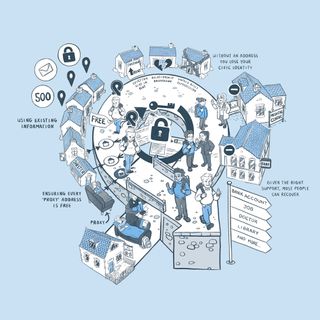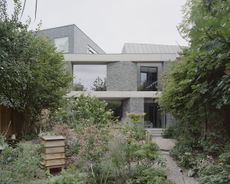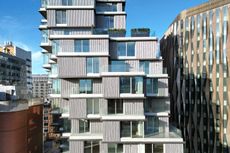Is ProxyAddress architecture’s answer to solving homelessness?
ProxyAddress founder Chris Hildrey talks to us about architecture changing the world, and his pioneering initiative to help solve homelessness

ProxyAddress was born out of one man's vision to solve homelessness. Fuelled by his passion for broadening the practice of architecture to help people who are experiencing homelessness, British architect Chris Hildrey devised a platform that provides stable addresses to those who need them. This offers them a valuable step towards accessing systems – such as creating bank accounts – which are often impossible without a fixed home location.
ProxyAddress, which kicked off as a residency research project at the Design Museum in London in 2017, has since won multiple awards and has been hailed as a pioneering way to support those in need.
Here, we catch up with Chris Hildrey about his vision, challenges, and ProxyAddress’ future.

Chris Hildrey
Founder Chris Hildrey on ProxyAddress
W*: What are the origins of ProxyAddress?
Chris Hildrey: In 2017, I was working at Niall McLaughlin's studio on their Natural History Museum project, and towards the end of it, it was winding down and I had an extra day so I applied to become a Designer In Residence at the Design Museum. The brief that year was ‘Support’. I was interested in the role of the architect in affecting positive change in the built environment. I was questioning some of the fundamental assumptions around architecture practice. I’ve also been really mindful of the effect of austerity. Architects are trained to change things but also on many fronts they are just sitting powerlessly by. I wanted to look at how to use my skills to try and intervene, and help improve the built environment.

W*: What led you to pick homelessness as your subject?
CH: It’s the most urgent of the needs. People are literally dying. And I was walking through the Design Museum and seeing all the amazing chairs and I thought – surely we have solved the chair problem. But at the same time, people suffer. There are these huge problems facing us that we are not engaged with. I went up and down the country and spoke to hundreds of people, people who are homeless, in temporary shelters, people who work with them, etc. And I discovered that all my preconceptions were wrong – the typical image you have of a homeless person is only a tiny fraction of the homeless population. The problem that unites them all is instability. Sometimes you have no anchor at all, and sometimes you have to keep moving very frequently and uproot your life all the time. Mental health or substance problems are a result of homelessness, not the reason.
Wallpaper* Newsletter
Receive our daily digest of inspiration, escapism and design stories from around the world direct to your inbox

W*: So, how does ProxyAddress work?
CH: ProxyAddress is a 'portal', a service. The addresses used are sourced in different ways. Local authorities have empty properties; also we work with housing associations. The properties don’t have to be empty, but sometimes they are. People also donate their address. So, we don’t work together with the homeless people, we work with the council, and provide a service to them. We also have partnerships with banks and other similar companies and organisations that recognise and help us set people up as they register. When someone uses a stable address, it removes the stigma of homelessness, when applying for a job for example.

W*: And does it work?
CH: We did a pilot in Lewisham, London, during the pandemic, which was a great stress test, and out of the 49 people taking part, 47 recovered from homelessness through using ProxyAddress.

W*: What is next for ProxyAddress?
CH: We go by ‘build slowly and fix stuff’ instead of ‘build fast and break stuff’. It is important that we comply with all sorts of fraud prevention aspects – anti-money mulling, anti-money laundering, anti-terrorism, etc – so we need to be careful when building [the project] and scaling up. But we want to expand it to different cities in the UK. In architecture we talk about community – one of the scary things is that homeless people lose their kin when they hit rock bottom, lose that community. ProxyAddress is not a physical thing, it’s a system, it is, for me, a broadening of the architecture practice.
Ellie Stathaki is the Architecture & Environment Director at Wallpaper*. She trained as an architect at the Aristotle University of Thessaloniki in Greece and studied architectural history at the Bartlett in London. Now an established journalist, she has been a member of the Wallpaper* team since 2006, visiting buildings across the globe and interviewing leading architects such as Tadao Ando and Rem Koolhaas. Ellie has also taken part in judging panels, moderated events, curated shows and contributed in books, such as The Contemporary House (Thames & Hudson, 2018), Glenn Sestig Architecture Diary (2020) and House London (2022).
-
 Aesop’s Salone del Mobile 2024 installations in Milan are multisensory experiences
Aesop’s Salone del Mobile 2024 installations in Milan are multisensory experiencesAesop has partnered with Salone del Mobile to launch a series of installations across Milan, tapping into sight, touch, taste, and scent
By Hannah Tindle Published
-
 Dial into the Boring Phone and more smartphone alternatives
Dial into the Boring Phone and more smartphone alternativesFrom the deliberately dull new Boring Phone to Honor’s latest hook-up with Porsche, a host of new devices that do the phone thing slightly differently
By Jonathan Bell Published
-
 Berlinde De Bruyckere’s angels without faces touch down in Venice church
Berlinde De Bruyckere’s angels without faces touch down in Venice churchBelgian artist Berlinde De Bruyckere’s recent archangel sculptures occupy the 16th-century white marble Abbazia di San Giorgio Maggiore for the Venice Biennale 2024
By Osman Can Yerebakan Published
-
 Timber-framed Wimbledon house is a minimalist, low-energy affair
Timber-framed Wimbledon house is a minimalist, low-energy affairA new timber-framed Wimbledon house is designed to blend into its traditional surroundings with a neat brick façade, careful massing and pared back interiors
By Jonathan Bell Published
-
 London Science Museum’s Energy Revolution gallery champions sustainable exhibition design
London Science Museum’s Energy Revolution gallery champions sustainable exhibition designThe Energy Revolution gallery opens at London’s Science Museum, exploring decarbonisation through sustainable exhibition design by Unknown Works
By Ellie Stathaki Published
-
 This South Downs house stands as a testament to the value of quiet refinement
This South Downs house stands as a testament to the value of quiet refinementAt one with the landscape, a South Downs house uses elements of quintessential country villas and midcentury gems with modern technologies
By Jonathan Bell Published
-
 Ash Tree House offers a contextual approach to a north London site
Ash Tree House offers a contextual approach to a north London siteAsh Tree House by Edgley Design is a modern family home in a north London conservation area's backyard site
By Ellie Stathaki Published
-
 In memoriam: John Miller (1930-2024)
In memoriam: John Miller (1930-2024)We remember John Miller, an accomplished British architect and educator who advocated a quiet but rigorous modernism
By Jonathan Bell Published
-
 River Wing at Clare College responds to its historic Cambridge heritage
River Wing at Clare College responds to its historic Cambridge heritageUniversity of Cambridge opens its new River Wing on Clare College Old Court, uniting modern technology with historic design
By Clare Dowdy Published
-
 Camden Workshop offers flexible family space in a transformed north London warehouse
Camden Workshop offers flexible family space in a transformed north London warehouseCamden Workshop, a transformed industrial space in north London, was designed by architects McLaren Excell to combine residential space and a creative studio for its owners
By Ellie Stathaki Published
-
 The Haydon shows off its dramatic stepped volume and triplex penthouse
The Haydon shows off its dramatic stepped volume and triplex penthouseThe Haydon, designed by architects Acme, reveals the triplex penthouse within its dramatic, stepped volume in London’s Aldgate
By Ellie Stathaki Published